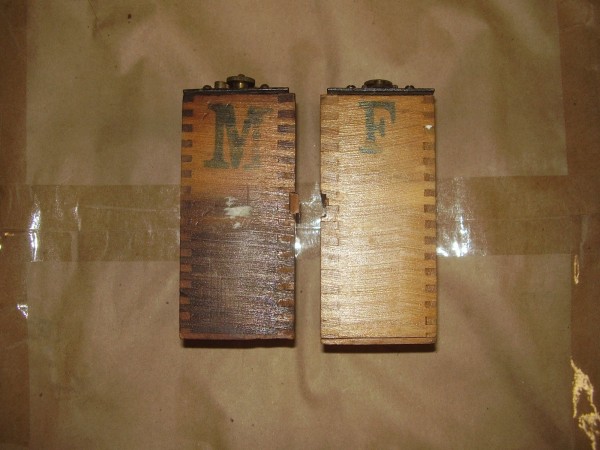Around the time of the T's introduction, the Heinze Electric Co. patented a mortise and tenon joint between pairs of its coils. The idea was to make the units a bit more secure in the box, helping to keep them from bouncing around in the box and losing contact. This joint required that the coils be made with one thick side to accomodate it. These thick sides then had to be adjacent to those of other coils, which meant that the coils had to be made and installed in the box in pairs, with "male" and "female" sides. These coils were stenciled with "M" and "F" so the assemblers would know which coils would get the tenon glued in. This was the first style Heinze coil used on the Model T:

When the coilbox lid was changed to include a pair of notched strips that, together with the cam style latches, kept the coils firmly in place, this joint was no longer needed and was eliminated, although the thick side was continued, probably because of the cutting machinery. These units were then stenciled "L" and "R," probably for "Left and Right":
Late in 1911, the "L" and "R" was changed to "Z" and "Y:"
I have no idea why this change took place. The best guess I can come up with is that Lowell, MA, where the Heinze Electric Company was located, had a very large Greek immigrant population, quite a few of whom worked for Heinze. Many Greek surnames begin with "Y" or "Z". Perhaps that had something to do with it.
Very early in the 1912 model year, the thick side was eliminated (all sides were now the same thickness) and the stencil changed to a large upper case "I". This continued into late 1912 when it changed to a more squat upper case "I" with prominent horizontal bars. The two 1912 units are shown side by side for comparison:
Finally, for 1913, the stencil changed to a large upper case "K":
In the quite different 1914 units, not shown here, the letters changed to "O" and later on, "A".
There are many other coil construction details accompanying these stenciling changes, but I'm focusing only on the stencils since that was Darren's question. Some markings, such as the "1/2" on Darren's coil and the long stream of small numbers on some other coils, have no known explanation. All the details I know, probably more than anyone is interested in, will appear when the article I'm working on for the magazine comes out.